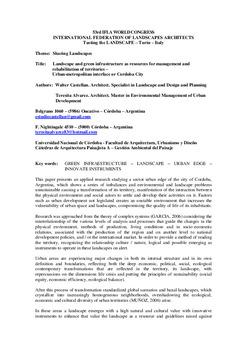| dc.description.abstract | This paper presents an applied research studying a sector urban edge of the city of Cordoba, Argentina, which shows a series of imbalances and environmental and landscape problems unsustainable causing a transformation of its territory, manifestation of the interaction between the physical environment and social actors to settle and develop their activities on it. Factors such as urban development not legislated creates an unstable environment that increases the vulnerability of urban space and landscapes, compromising the quality of life of its inhabitants.Research was approached from the theory of complex systems (GARCIA, 2006) considering the interrelationship of the various levels of analysis and processes that guide the changes in the physical environment, methods of production, living conditions and in socio-economic relations, associated with the production of the region and on another level to national development policies, and / or the international market. In order to provide a method of reading the territory, recognizing the relationship culture / nature, logical and possible emerging as instruments to operate in these landscapes on alert.Urban areas are experiencing major changes in both its internal structure and in its own definition and boundaries, reflecting both the deep economic, political, social, ecological contemporary transformations that are reflected in the territory, its landscape, with repercussions on the dimensions life crisis and putting the principles of sustainability (social equity, economic efficiency, ecological balance).After this process of transformation standardized global scenarios and banal landscapes, which crystallize into increasingly homogeneous neighborhoods, overshadowing the ecological, economic and cultural diversity of urban territories (MUÑOZ, 2006) arise. In these areas a landscape emerges with a high natural and cultural value with innovative instruments to enhance that value the landscape as a resource and guidelines raised against different real situations and different problems and possible unwanted (collective imaginary) situations.We understand the landscape as the image of an inclusive and container unit of all structures and all processes that allow the existence of human beings. This concept of landscape, aesthetic and environmental, involving cultural, social, economic, and natural, ecological aspects. The landscape is recognized as an emerging joint between man and his natural environment, understanding and interpretation is key to improving the quality of life, and ensuring environmental conservation as a basis for the development of citizens against the paradigmatic changes XXI century in Latin American cities.The proposals developed aim to recover those disturbed landscapes, with an image of their own idiosyncrasies, environmentally balanced, making possible adequate, rational and adapted to the economic, technological possibilities, and functional requirements of local society responses to it which proposes:? Strengthening the identity and the importance of the density of regional cultural legacy, for a balance between the local and the global, addressing environmental, social, physical functional imbalances present in this present world, which affects the dynamics of territory affecting natural support.? Incorporation of the environmental dimension in the landscape in the formation of new looks to achieve sustainable-development based on a balanced and harmonious relationship between social needs, economic activity and the environment where the landscape is a resource for ordering and regional planning.? Recognition of the landscape and infrastructure as an emerging topical lap joint between man and his natural environment where understanding and interpretation is key to improving the quality of life, and ensuring environmental conservation as a basis for the development of citizenship paradigm shifts compared to the XXI Century.? Recognition of peri-urban territories edges and infrastructural landscapes situations subject to high impact and scenarios for environmental management and restoration of the landscape to enhance its ability to re muted defensive and proactive projects? Approach urban rereading from an environmental look to act on the resilient landscapes and ecosystems on their capabilities, to return to its initial state, recovering their values and positive attributes, not their weaknesses and disorders.It?s necessary a way to reflect on a management and land use planning, consider the landscape as an emerging resource for sustainable development and on the other hand consider strengthening the infrastructure (that make up the open spaces vacant, ecological corridors, courses water, etc. and / or post landscapes-industrial, mining, landfills obsolete) as a green / hybrid network interconnecting environmental value landscapes, forming a basic, ecological and complex structure that can address threats to biodiversity, integrated territorial-urban policies and increase the resilience of ecosystems in the territories of edges subjected to impacts of some sort to return to its initial state. | es |





